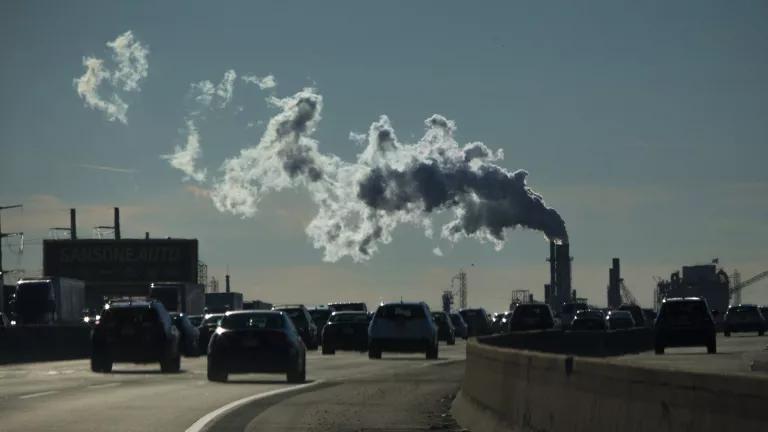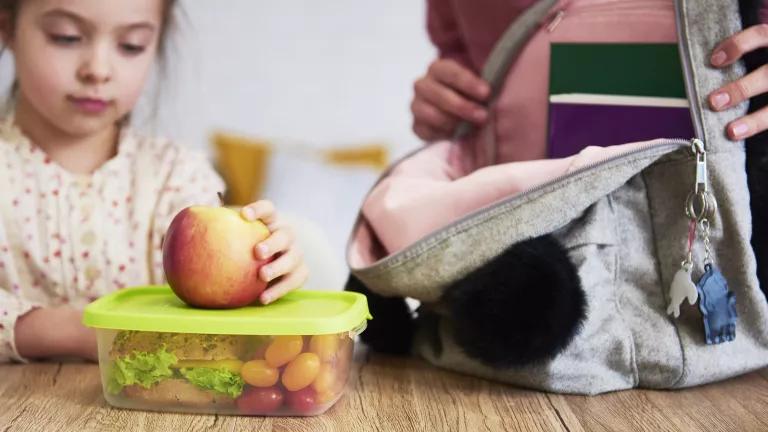Pandemic Endangers Slaughterhouse Workers and Supply Chains

Learn more about NRDC’s response to COVID-19.
“My life is in jeopardy because we’re working elbow to elbow,” slaughterhouse workers report.
There is widespread fear as the COVID-19 pandemic illuminates longstanding injustices that leave “essential” workers unprotected and put our public health at risk. As the virus roils the food system and threatens supply chain disruptions, the industrial food animal production system—responsible for nearly all the meat, eggs, and dairy Americans eat—is particularly vulnerable. This week, for instance, the country’s largest pork producer, Smithfield, closed one of the country’s largest meat processing plants. This plant is now the single largest COVID-19 hot spot in the country, and alone it produced five percent of the US pork supply. This highlights three things: (1) the immediate and longstanding dangers facing slaughterhouse workers, (2) the big-picture problems with our system of industrial animal agriculture that make workers vulnerable and imperil food security, and (3) the immediate actions that policymakers can take to protect workers and food safety.
This turmoil threatens workers, farmers and consumers. The half a million US workers employed in slaughterhouses, and the growers who supply animals to them, bear the brunt of risk when the system breaks down. But with a highly vertically integrated supply chain, this has the potential to impact feed growers, truck drivers, and many more, sending shockwaves through the economy. Families from California, to Iowa, to North Carolina, and other places where animal agriculture is a leading employer, worry for their livelihoods. Families sheltering in place, especially those who cannot afford to stock their freezers, worry about the possibility of skyrocketing food prices, but no one wants to sacrifice food or worker safety. Watching as plants close and disease spreads, farmers, workers, and families alike are asking themselves what’s next? Who’s next?
Slaughterhouse Workers on the Frontlines of the Crisis
Even before the current COVID-19 pandemic, slaughterhouse workers labored at enormous risk to themselves. For instance, these workers are three times as likely as the typical worker to have severe injuries, such as those leading to grisly amputations. As the South Dakota case illustrates, many slaughterhouse workers are themselves refugees and recent immigrants with few other job options. Making matters worse, the Trump Administration recently relaxed safety standards, and allowed the industry to set its own processing speeds, severely heightening worker risk. The USDA’s own Inspector General questioned whether the agency cooked or concealed the worker safety data in making that decision.
The COVID-19 crisis is worsening the health risks facing these workers, and hitting the heavily consolidated corporate meat supply chain hard. According to the Associated Press, plants in Colorado, South Dakota, Iowa, Pennsylvania, and Mississippi have already reported hundreds of COVID-19 cases and there are new reports of illness and death every day. This is not surprising given that slaughterhouse workers typically stand “elbow to elbow” for long shifts, and without adequate protection. In one case when workers did get masks, workers were forced to pay the company for their own supplies. Throughout the country many workers are sick, and many more fear what’s yet to come. Some slaughterhouses report a 50% decline in workforce, and others are seeing a third of workers staying home. And due to this supply chain breakdown several companies are directing farmers to dramatically “depopulate” their animals. This means killing millions of baby pigs and chicks en masse in the field (often by suffocation), rather than raising them for meat and sending them for slaughter and sale.
In North Carolina, home to the top pork-producing-counties in the country where animal agriculture is a top employer, slaughterhouses have pledged to take precautions such as offering limited sick days to employees, but are also offering perverse incentives to employees such as cash bonuses to workers who do not actually use any sick days. This places workers at unnecessary risk of contracting the virus from a colleague.
Farmers Trapped in a Broken Food Chain
Farmers also suffer under this system. As slaughterhouse production slows or halts, the effects reverberate through the supply chain. For example, the mass “depopulations” underway leave farmers wondering how much they will be paid this year. Although at least one industrial actor has vowed that farmers will be “fairly compensated” for their animals, big questions remain about what exactly industry means by that. For example, farmers are wondering what impacts the cullings will have on both immediate income and future earnings. These questions linger as overall herds and flocks are reduced, but growers' debt burdens do not reduce accordingly.
Making matters worse, the poultry sector fears another “highly pathogenic” outbreak of bird flu, which threatens flocks and even bigger losses and instability.
Workers, Farmers, and Our Food Supply Need Protections Now
The strains on our supply chain spotlighted by the current crisis underscore that we need a fundamental overhaul of our food system to protect people who work in it, safeguard people who live near production sites, ensure sufficient safeguards to protect food safety, and ensure that resources are managed so that they remain available for future generations. Industry has long touted the consolidation and integration that helped amass corporate power as “efficient.” The current crisis, however, has made clear what many working in the food supply chain have long known: these same “efficient processes” have left our whole food system--from farm to fork--vulnerable when single linchpins (such as slaughterhouses) are impacted. As one expert put it, "to truly be resilient, our system must shift to one that relies on small and medium producers and independent, responsible operations."
We need to act in the immediate short term. There are concrete actions that policymakers can take now to protect workers, and ensure continuity of our food supply:
- Require stronger workplace standards.
- OSHA must set an infectious disease standard, and provide the agency with adequate enforcement mechanisms and staff: Alarmingly, no such standard exists for slaughterhouse workers or others. OSHA has the authority to set this up, but Congress ought to mandate it. Congress also needs to increase OSHA’s ability to enforce the law with stronger penalties and staff to enforce them. Workers and their advocates should have the right to go to court to enforce the law when the government fails.
- Require employers to provide personal protective equipment at the employer's own expense.
- Reinstate safer line speeds at slaughterhouses: The Trump Administration relaxed safeguards limiting how fast pork producers could run their slaughterhouse lines, and lines that go too fast contribute greatly to worker injuries. The current system, which should be stopped, allows industrial meat producers to make up their own rules. Congress should put an end to this and reinstate safer line speeds.
- Ensure the most vulnerable food system workers, including farm laborers and slaughterhouse workers, have emergency care: As I have written, the CARES Act does provide critical funding for rural healthcare, but does not mandate that it be targeted to set up emergency facilities for the most vulnerable rural food system workers. Congress can, and should, immediately set up emergency facilities accessible to workers and their families.
- Provide support for industrial meat producers who want to switch to more resilient and sustainable production methods: The National Chicken Council called for federal support for their own contract growers through the CARES Act relief package passed by Congress, but there are proposals in Congress that would support farmers who want to transition out of this system. Congress could take steps to implement some of those plans in response to COVID-19, especially for farmers who lose income as their current supply chains break down. In the immediate-term, a portion of the $9.5 billion CARES Act funding allocated to support farmers, including livestock producers, should be used to assist growers seeking to transition out of the industrial system.
Upton Sinclair’s “The Jungle” changed oversight of our food in this country more than a century ago—spurring immense public outrage, and ultimately, leading to the passage of the Meat Inspection Act of 1906. When people first read about the conditions of the Chicago slaughterhouses, it sounded too awful to be believable.
When we look at the situation in South Dakota, Georgia, and other states today we see the numbers and we see the people getting sick. We can’t deny the truth—and after Covid-19, these problems will still exist unless we commit to protecting people who work in the industry, safeguard people who live near production sites, and ensure that resources are managed so that they remain available for future generations.



